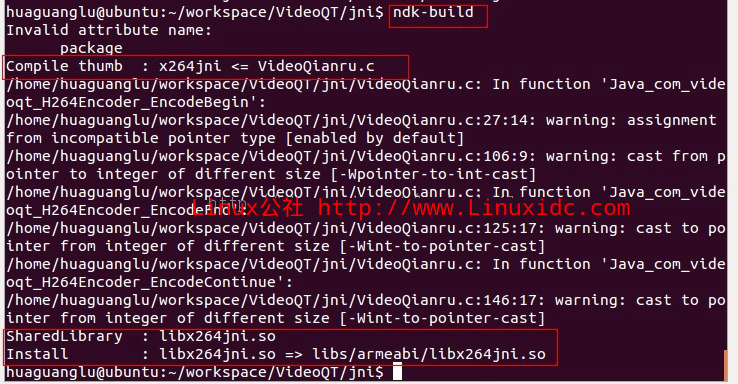在~/workspace/VideoQT/目录下,新建jni目录,在jni目录下,新建libx264目录,在libx264目录下,新建include和lib目录。将~/bysj/x264-snapshot-20131228-2245/目录下的x264.h,x264_config.h拷贝到include目录下,将libx264.a拷贝到lib目录下。在jni目录下,新建Android.mk文件,其脚本程序为:
LOCAL_PATH := $(call my-dir)
include $(CLEAR_VARS)
LOCAL_C_INCLUDES +=$(LOCAL_PATH)/libx264/include
LOCAL_MODULE := x264jni
LOCAL_SRC_FILES := VideoQianru.c
#LOCAL_LDLIBS := $(LOCAL_PATH)/libx264.a
LOCAL_LDLIBS := -L$(SYSROOT)/usr/lib -llog -lgcc
LOCAL_LDFLAGS += $(LOCAL_PATH)/libx264/lib/libx264.a
#LOCAL_LDLIBS += $(LOCAL_PATH)/libx264.a
#LOCAL_LDLIBS := -L$(SYSROOT)/usr/lib -lgcc
include $(BUILD_SHARED_LIBRARY)
在jni目录下,新建文件VideoQianru.c文件,写jni程序,链接JAVA与C层。然后,终端到jni目录,输入ndk-build,完了之后,就会在VideoQT/libs/armeabi/目录下生成libx264jni.so文件。如图:

VideoQianru.C文件的代码为
#include
#include
#include
#include
#include
#include
typedef struct
{
x264_param_t * param;
x264_t *handle;
x264_picture_t * picture;
x264_nal_t *nal;
} Encoder;
jlong Java_com_videoqt_H264Encoder_EncodeBegin(JNIEnv* env, jobject thiz,
jint width, jint height) {
// int i=0;
// static int j=0;
static hua_k=0;
Encoder * en = (Encoder *) malloc(sizeof(Encoder));
//FILE *hua_fp=fopen("/sdcard/x264H264Androidx264.txt","w+");
//fprintf(hua_fp,"hua_k=%d,Java_h264_com_H264Encoder_CompressBegin2014-02-19:1\n",hua_k);
hua_k++;
//fflush(hua_fp);
en->param = (x264_param_t *) malloc(sizeof(x264_param_t));
en->picture = (x264_param_t *) malloc(sizeof(x264_picture_t));
//x264_param_default(en->param); //set default param 浣跨敤//by hgl
x264_param_default(en->param); //set default param by other person
//en->param->rc.i_rc_method = X264_RC_CQP;
//x264_param_default_preset(en->param, "fast", "zerolatency");
x264_param_apply_profile(en->param,"baseline");
en->param->i_log_level = X264_LOG_NONE;
en->param->i_width = width; //set frame width
en->param->i_height = height; //set frame height
en->param->rc.i_lookahead =0;
//en->param->rc.f_rf_constant=25;
//en->param->i_level_idc=12;
en->param->ref=16;
//en->param->i_frame_total=300;
//en->param->rc.i_rc_method = X264_RC_CRF;
/en->param.rc.i_vbv_max_bitrate=(int)((m_bitRate*1.2)/1000) ;
//
en->param.rc.i_bitrate = (int)m_bitRate/1000; ///*from here add by hgl 2013-12-31 10:06*/
en->param->i_csp=X264_CSP_I420;
en->param->i_frame_reference=1;
//
//
//en->param->i_threads=1;
//en->param->b_intra_refresh=1;
//en->param->i_bframe=0;//0
//en->param->b_annexb=1;
//en->param->b_cabac=0;//0
//en->param->i_cabac_init_idc=-1;//-1
//if(i<1000){
//en->param->hua_level[0]=-255;
//i++;
//fprintf(hua_fp,"绗?d娆★紝%d\n",j,en->param->hua_level[0]) ;
//j++;
//}
//en->param->rc.b_cbr=1;
en->param->i_fps_num =25;
en->param->i_fps_den = 1;
//en-> param->i_keyint_max =25;
//en->param->i_fps_num =5 ;
/*to here add by hgl 2013-12-31 10:06*/
//en->param->b_open_gop = 1;
//en->param->i_fps_den = 1;
//by hgl from
//if ((en->handle = x264_encoder_open(en->param)) != 0) {
//for(i=0;i<1000;i++){
//fprintf(hua_fp,"绗?d娆★紝%d\n",j,en->param->hua_level[0]) ;
// }
//j++;
//}
//else{
// return 0;
//}
//by hgl to
if ((en->handle = x264_encoder_open(en->param)) == 0) {
return 0;
}
/* Create a new pic */
x264_picture_alloc(en->picture, X264_CSP_I420, en->param->i_width,
en->param->i_height);
return (jlong) en;
}
jint Java_com_videoqt_H264Encoder_EncodeEnd(JNIEnv* env, jobject thiz,jlong handle)
{
Encoder * en = (Encoder *) handle;
if(en->picture)
{
x264_picture_clean(en->picture);
free(en->picture);
en->picture = 0;
}
if(en->param)
{
free(en->param);
en->param=0;
}
if(en->handle)
{
x264_encoder_close(en->handle);
}
free(en);
return 0;
}
jint Java_com_videoqt_H264Encoder_EncodeContinue(JNIEnv* env, jobject thiz,jlong handle,jint type,jbyteArray in, jint insize,jbyteArray out)
{
Encoder * en = (Encoder *) handle;
x264_picture_t pic_out;
int i_data=0;
int nNal=-1;
int result=0;
int i=0,j=0;
int nPix=0;
jbyte * Buf = (jbyte*)(*env)->GetByteArrayElements(env, in, 0);
jbyte * h264Buf = (jbyte*)(*env)->GetByteArrayElements(env, out, 0);
unsigned char * pTmpOut = h264Buf;
int nPicSize=en->param->i_width*en->param->i_height;
jbyte * y=en->picture->img.plane[0];
jbyte * v=en->picture->img.plane[1];
jbyte * u=en->picture->img.plane[2];
memcpy(en->picture->img.plane[0],Buf,nPicSize);
for (i=0;i
{
*(u+i)=*(Buf+nPicSize+i*2);
*(v+i)=*(Buf+nPicSize+i*2+1);
}
switch (type)
{
case 0:
en->picture->i_type = X264_TYPE_P;
break;
case 1:
en->picture->i_type = X264_TYPE_IDR;
break;
case 2:
en->picture->i_type = X264_TYPE_I;
break;
default:
en->picture->i_type = X264_TYPE_AUTO;
break;
}
if( x264_encoder_encode( en->handle, &(en->nal), &nNal, en->picture ,&pic_out) < 0 )
{
return -1;
}
for (i = 0; i < nNal; i++){
memcpy(pTmpOut, en->nal[i].p_payload, en->nal[i].i_payload);
pTmpOut += en->nal[i].i_payload;
result+=en->nal[i].i_payload;
}
return result;
}





















 137
137











 被折叠的 条评论
为什么被折叠?
被折叠的 条评论
为什么被折叠?








